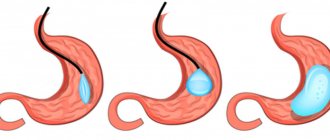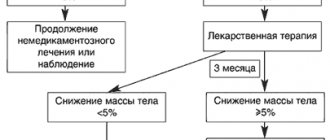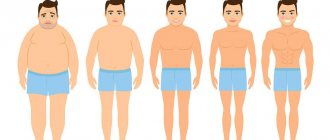Have you noticed that sometimes all attempts to lose weight do not lead to the desired result? Why do you think this happens? You can’t stick to proper nutrition for a long time, you have breakdowns in eating, overeating, you skip workouts and don’t exercise at home? What is the reason?
If you can’t give an exact answer, then perhaps the main reason for your failures is that you are not struggling with excess weight. In fact, there are as many as 6 types of obesity, and each of them should have a special approach both in nutrition correction and in training.
A practicing nutritionist or nutrition consultant who has completed courses in dietetics and has the appropriate certificate can help you create the right diet. An experienced trainer should develop a training program (it is advisable that he also undergoes basic training in nutrition and understands the peculiarities of weight correction).
And so that you have an understanding of what we are talking about, experts from the school of nutritionists at the Wellness Consulting Academy will talk about the types of obesity and the causes of each of them. You will understand why excess fat accumulates in this particular place, and how to stop the process of its accumulation. Well, let's begin...
Obesity overeating
“Yes, how long do I eat there? I hardly eat anything, but the weight is still creeping up. And where does it come from?” - have you encountered similar reasoning from a fat person, or perhaps you say so yourself?
In fact, weight gain can only occur if a person eats more calories than he expends (we do not take into account complex genetic diseases or serious metabolic disorders, when obesity is caused by health problems). So excess weight is almost always a consequence of overeating and excessive caloric intake.
It may seem like you eat almost nothing, but it’s that same coffee and cookies consumed at work every 2 hours to unwind that turns you from slender to fat. An abundance of simple carbohydrates in your diet, a love of baking and sweets, the habit of adding extra to yourself, regular all-inclusive vacations, three-course lunches, fast food dinners on weekends - this is what ruins you.
With obesity, overeating and an excess of simple carbohydrates, fat deposits accumulate in the upper part of the body: on the face, around the neck, in the chest area, on the abdomen. And the arms and legs can remain quite thin.
To start losing weight with this type of obesity, you need:
- Strictly limit sweets, any confectionery, pastries, sugar, starchy carbohydrates (if you don’t know how to dose sweets, then it’s better to give them up completely until you pull yourself together).
- Replace the usual sweets with dried fruits, nuts, fruits, berries, natural jelly and pastilles made from them based on agar-agar.
- Eliminate from your diet any carbonated drinks and store-bought juices (they contain a lot of sugar!), fast food, processed foods, dishes and foods that contain mayonnaise or margarine (as well as any other hydrogenated fats), highly fatty and fried foods.
- Reduce the amount of sugar you add to food and drinks when preparing (you can train yourself to drink tea and coffee without sugar at all or add zero-calorie stevia to them).
- Adjust your drinking regime by starting to drink 1.5-2 liters of purified water per day.
- Start drinking a glass of water in the morning on an empty stomach and an hour before bedtime, a glass half an hour before each meal and an hour after, stop drinking water during meals.
- Buy a gym membership and exercise 2-3 times a week for 1-1.5 hours, focusing on cardio (or at least train at home daily for 30-45 minutes).
Please note that sometimes obese binge eating is confused with an eating disorder, specifically binge eating disorder. To understand what you are dealing with: a banal lack of willpower and restraint or, after all, an eating disorder, differentiate according to the main manifestations.
Thus, with a normal eating disorder, a person states his love for tasty food, he admits that he often eats for company, while watching TV or reading a book, out of boredom and lack of emotions. If we are talking about compulsive overeating, then you will be faced with the fact that a person eats on the sly, when no one sees, more often he overeats at night or alone, while in public demonstrating restraint in portions.
After overeating, he is tormented by a feeling of guilt and shame, he engages in self-flagellation and may even punish himself for another weakness. A nutrition consultant can understand this quite simply - you just need to ask leading questions and monitor the answers or at least the client’s reaction (people with eating disorders often hide their difficult relationship with food, trying to look completely adequate).
A nutritionist whose course is aimed at helping people with compulsive overeating should first of all use psychotherapy techniques, and only then adjust the diet towards reducing portions and calories.
Obesity of inactivity
This problem usually catches former athletes and fitness leaders by surprise, who trained for a long time, and then gave up training and began to lead a passive lifestyle. They walk little, prefer sedentary work, and rarely have active hobbies. Therefore, they have a large belly against the background of slight fullness in the rest of the body.
To reduce the symptoms of obesity and inactivity, you need to:
- Limit the amount of simple carbohydrates and sweets to a minimum, replacing them with complex carbohydrates: vegetables, fruits, berries, dried fruits, whole grain bread.
- Switch to fractional meals in small portions to reduce the risk of overeating at main meals.
- Return to an active lifestyle, starting with short but regular training, first at home, then in the gym.
- To love active games in the fresh air, to practice active pastime: cycling, roller skating, skating, rope park, trampolining, laser combat, kayaking, etc.
Celiac obesity
This type of obesity is characterized by the accumulation of excess fat in the legs and thighs. Often, people with celiac obesity experience hormonal imbalances (for example, changes in hormonal levels during menopause).
To reduce its manifestations and moderate excess body weight gain, you need:
- Seek advice from an endocrinologist, he will conduct the necessary examination and prescribe tests for specific hormones.
- Stop being nervous and worrying about anything, because stress often causes hormonal imbalance.
- Stop smoking and drinking alcohol - they complicate hormonal correction prescribed by your doctor.
- Accustom yourself to regular physical activity, start leading an active lifestyle, which will “overload” your metabolism and help fight obesity.
How to get rid of excess weight
At home, stage 1 obesity in women can be treated after examination by a specialist. In our clinic, after consulting a nutritionist and ordering tests, patients receive recommendations to help them cope with excess fat deposits.
For patients with stage 2 obesity, treatment includes changes in diet and physical activity. If hormonal imbalances are detected, the doctor prescribes drugs that stabilize the endocrine system. Our clinic’s specialists treat obesity of any degree in Moscow. Even the most advanced situations can be corrected with a careful approach, and you can regain your slim figure and health.
The page is for informational purposes only. Find out the exact list of services provided and the specifics of the procedures by calling.
Nervous obesity
“I have a very nervous job, so I calm myself down with sweets,” have you heard this reasoning? Regular exposure to stress causes cravings for simple carbohydrates and the desire to eat anxiety. The fact is that sweets can temporarily improve your mood, as they lead to a sharp increase in blood glucose levels and the production of happiness hormones.
However, such love also has a side effect, namely, excess weight gain. It is also worth considering that in stressful situations, the body begins to intensively produce the hormone cortisol, which increases the accumulation of fat deposits and leads to the fact that fat accumulates mainly in the abdomen (the abdominal type of obesity is formed).
To lose weight at the waist and regain your beautiful figure, you need:
- Learn to control your emotions and stop worrying so much. If necessary, go to a psychologist or coach, because taking sedatives only helps fight the consequences, not the cause of stress.
- Find the type of workout that will bring you joy. It has already been proven that physical activity helps relieve stress and chronic fatigue, because as a result of exercise, endorphins, hormones of happiness, are produced.
- Start distracting yourself from thoughts about food thanks to positive emotions. Meet with friends more often, surround yourself with positive people, watch humorous programs and comedies, find your favorite hobby, walk in the fresh air, travel, attend interesting events.
- Look for positive moments even in problematic situations; in the end, they give you invaluable experience that helps you develop and improve yourself.
- Live here and now, without looking back at the past, living every moment to the fullest, enjoying the little things.
- Appreciate what you have rather than be upset about what you don't have.
- Start thanking life for what happens in it and people for what they do for you.
- Get rid of envy, criticism and self-criticism.
- Forgive all your offenders, do not live in disappointments, love yourself and allow yourself to be a happy person.
Etiology and pathogenesis
The etiology of obesity is quite complex and data on it are contradictory. Obesity is based on the interaction of genetic predisposition and external factors. Currently, it is difficult to influence a genetic defect and clinicians pay the main attention to external factors, which primarily include the nature of nutrition and the level of physical activity.
However, it is impossible to consider etiological factors in isolation. To ensure energy balance, energy consumption must be equal to its expenditure. Energy consumption occurs only through food intake. Energy consumption in the body consists of the level of metabolism, heat generation and physical activity. Moreover, 60-65% of energy is spent on basal metabolism, 10% on thermogenesis, and only 25-30% of energy on physical activity (A.M. Mkrtumyan, 2003).
A simple mathematical calculation shows that it is enough to take one “extra”, i.e. not overlapping energy costs, a sandwich with cheese or a glass of milk per day, so that body weight increases with the same physical activity by 10 kg in 10 years. However, most people maintain normal body weight, having a flawlessly functioning hunger and satiety center that maintains a balance between energy intake and energy expenditure: it turns on the rapid oxidation of fat in response to its increased consumption, thereby preventing its deposition. In recent years, the role of adipose tissue itself in the genesis of obesity and associated complications has been actively discussed (I.I. Dedov et al., 2004). But consideration of the effects of adipose tissue on the functioning of the body is associated with the influence of dysfunction of the hunger center and satiety is more etiopathogenetically justified, since today there is no clear idea about the primacy of the place of origin of the trigger mechanism in the development of obesity.
All effects of adipose tissue on metabolic processes in the body are associated with the production of leptin. The new hormone of white adipose tissue, leptin, was discovered relatively recently (1994) thanks to modern research methods in molecular biology. Today, adipose tissue is considered as a gland that secretes adipocyte-specific factors (adipokines) that are involved in the neuroendocrine regulation of energy metabolism. Leptin is one of these factors, which, as it turns out, influences a number of vital processes.
Leptin receptors were first discovered in the nuclei of the hypothalamus. The effect on them is manifested by increased production of gonadotropin releasing hormone and secretion of gonadotropins. The presence of such receptors was also discovered in the anterior lobe of the pituitary gland, white adipose tissue, chorion, placenta and ovaries, in endometrial cells, epithelial and stromal cells. Based on these data, it was hypothesized that leptin production by adipose tissue is under neuroendocrine control.
Leptin plays an important role in the regulation of energy metabolism, especially fat metabolism, contributing to a decrease in fat storage (adipocyte apoptosis). In addition, its interaction with other hormonal mediators of homeostasis has been noted: growth hormone, insulin, glucagon, insulin-like growth factor, growth agonadotropic hormones and glucocorticoids [6, 7].
A number of authors call leptin the “satiety hormone” because of its ability to influence a person’s feeling of hunger by acting on the receptors of the hypothalamus, leading to appetite suppression. At the same time, the use of endogenous lipids in energy metabolism also increases, along with a decrease in fat reserves. [8, 9]. At the same time, the number of receptors is a constant value, and with an increase in the level of leptin, as well as with chronic hyperleptinemia in the serum, there should be a constant suppression of the hunger center and activation of the satiety center. But this does not happen in clinical practice. On the contrary, the greater the body weight, the more frequent and plentiful the food intake.
Great difficulties in the treatment of obesity are created by the fact that adipose tissue is not metabolically homogeneous. Adipocytes contain a2- and p-adrenergic receptors that promote lipolysis, the number and activity of which are not the same in adipocytes of different parts of the body, which creates the heterogeneity of adipose tissue (J. Seidell, K. Flegal, 1997). Differences have been found in the effects of insulin and catecholamines on fat depots of different locations (J. Albu, M. Curi, M. Shur, L. Murphy, D. Matthews, F. PiSunyer, 1999). Parathyroid hormone causes lipolysis only in the fat depots of women and is intact in men (MB Katan, 2002). The sensitivity of fat in depots of different locations to lipolytic influences is heterogeneous. Fat breakdown occurs more actively in adipose tissue located in the chin, neck, supraclavicular and subclavian fossae. The most stable and difficult to disintegrate is the fat located on the anterior abdominal wall and especially in the buttocks. Abdominal depots are more easily subject to lipolysis than subcutaneous ones (J. Albu, M. Curi, M. Shur, L. Murphy, D. Matthews, F. Pi-Sunyer, 1999). The different properties of fat deposits are due to the fact that the number of catecholamine receptors on the membranes of adipocytes located in the area of the chin, neck, and upper chest significantly exceeds the number of receptors in fat cells in the abdomen, buttocks, and thighs. It is clear that any method of influencing adipose tissue causes lipolysis mainly in those fat deposits in which there are many catecholamine receptors, while the fat “apron” and “breeches” are practically not amenable to therapy. In addition to adrenergic receptors, the rate of lipolysis in fat depots is affected by different activity of lipoprotein lipase: it is maximum in women in the thigh area, minimal in both women and men in the omentum. The issue of increasing lipase activity has not been studied.
The development of the female body from birth to maturation and decline is usually divided into separate periods, which are characterized by certain morphological and functional features. In any of these periods, the factor of obesity can have an adverse effect on the formation, formation and function of the reproductive system.
In order for a woman to have and establish a normal menstrual cycle, and therefore the ability to bear children, a threshold, minimum amount of fat must accumulate in her body, since adipose tissue is involved in the regulation of reproductive function. When analyzing the state of a woman’s reproductive function, the premorbid background is judged by age at menarche. Over the past 100 years, the age of menarche has changed, it occurs at an earlier age, the average age is 12.6 years (L. Lee, S. Kumar, L. Leong, 2000).
Obese adolescents experience either late or early menarche. Earlier menarche is due to acceleration, since there is a certain relationship between the average body weight at the time of menarche and average age. How the amount of fat affects the age of menarche is still impossible to determine precisely, since the reaction of the hypothalamus to the loss or accumulation of body fat mass is ambiguous.
Many women of reproductive age who are obese have irregular menstrual cycles. As is known, gonadotropin-releasing hormones play a key role in the regulation of reproductive function and, possibly, the hypothalamus responds to changes in estrogen levels. The connection between the amount of adipose tissue and estrogen content was identified in a number of studies by P. Sinteri and P. MacDonald (1981), who found that aromatization of androgens occurs in adipose tissue and in this way a third of circulating estrogens are formed.
Often in obese patients, previously regular menstrual function is disrupted at one stage or another in the patient’s management and it can be difficult to restore it. Menstrual irregularities in the form of dysfunctional uterine bleeding, oligo- and amenorrhea are extremely common. High incidence of infertility.
Excess adipose tissue leads to the accumulation of steroids, and the amount and activity of estrogen circulating in the blood decreases. Abnormal functioning of the hypothalamus leads not only to irregular menstrual cycles, but also to hypomenstrual syndrome and secondary amenorrhea. V.N. Serov (1968), when studying menstrual function in women with postpartum obesity, revealed a violation of tonic and cyclic secretion of gonadotropins, leading in 63% of cases to the development of anovulatory bleeding, followed by the development of hypomenstrual syndrome or acyclic bleeding against the background of endometrial hyperplastic processes .
According to most researchers, menstrual irregularities are secondary and are a consequence of obesity. With alimentary obesity, menstrual dysfunction is 6 times more likely and primary infertility is almost 2 times more likely. There is a direct relationship between an increase in body weight and the severity of ovarian dysfunction, which is accompanied by anovulation, inferior luteal phase of the cycle and a decreasing number of pregnancies (W. Saris, 1998).
Obesity of venous channels
It is believed that this type of obesity has a genetic basis and is inherited. In this case, fat accumulates mainly in the legs and, as a rule, women (especially pregnant women and older women) suffer from this obesity.
To deal with this problem, you need:
- Go for a consultation with an experienced phlebologist and undergo an examination for varicose veins, the condition of blood vessels and veins in the lower extremities.
- Develop leg muscles through regular exercise.
- Walk or run as often as possible (if the condition of the veins is not critical and there is no risk of rupture).
- Avoid wearing weights and exercising with weights.
- Do everything possible to normalize your weight, since extra pounds only aggravate the problem with varicose veins.
Causes of obesity in women
Traditionally, women are much more concerned with their appearance than men, and beauty standards dictate that a beautiful woman is first and foremost a thin one. Starting from an early age on various diets, often incompatible with each other and even harmful, girls achieve the opposite effect: the body does not have a stable supply of nutrients, and tries to accumulate any calories, turning them into fat. So the causes of obesity in women most often need to be looked for in the field of psychology, which is what specialists at the Rehab Family clinic successfully do.









